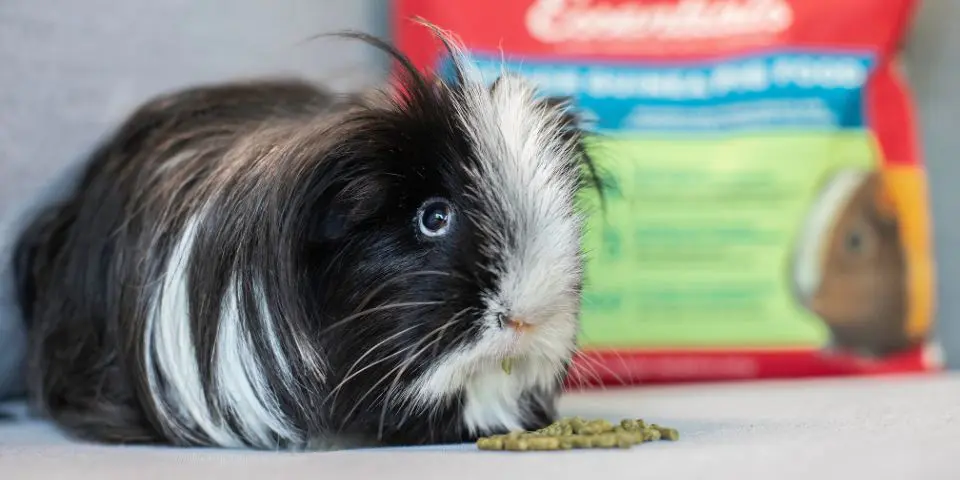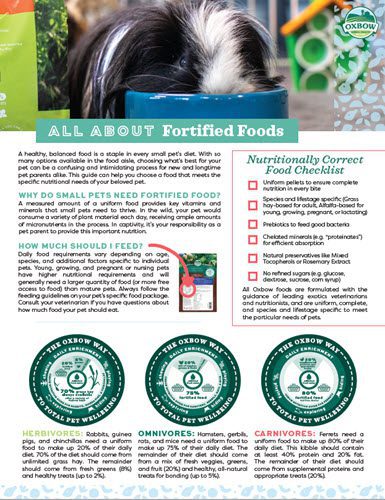Updated: May 31, 2024
A healthy, balanced food should be a staple in every small pet’s diet. With so many options available in the food aisle, choosing one that’s best for your furry family member can be confusing. Download our All About Fortified Foods guide to help you choose a food that meets the specific nutritional needs of your beloved pet!
Why Do Small Pets Need Fortified Food?
A measured amount of a uniform food provides key vitamins and minerals that small pets need to thrive. In the wild, your pet would consume a variety of plant material each day, receiving ample amounts of micronutrients in the process. In captivity, it’s your responsibility as a pet parent to provide this important nutrition.
How Much Food Should I Give My Pet Each Day?
Daily food requirements vary depending on age, species, and additional factors specific to individual pets. Young, growing, and pregnant or nursing pets have higher nutritional requirements and will generally need a larger quantity of food (or more free access to food) than mature pets. Always follow the feeding guidelines on your pet’s specific food package. Consult your veterinarian if you have questions about how much food your pet should eat.
Nutritionally Correct Food Checklist
- Uniform pellets to ensure complete nutrition in every bite
- Species and lifestage specific (Grass hay-based for adult, Alfalfa-based for young, growing, pregnant, or lactating)
- Prebiotics to feed good bacteria
- Chelated minerals (e.g. “proteinates”) for efficient absorption
- Natural preservatives like Mixed Tocopherols or Rosemary Extract
- No refined sugars (e.g. glucose, dextrose, sucrose, corn syrup)
All Oxbow foods are formulated with the guidance of leading exotics veterinarians and nutritionists, and are uniform, complete, and species and lifestage specific to meet the particular needs of pets.

Feeding Recommendations For Herbivores (Rabbits, Guinea Pigs, and Chinchillas):
Rabbits, guinea pigs, and chinchillas need a uniform food to make up 20% of their daily diet. 70% of the diet should come from unlimited grass hay. The remainder should come from fresh greens (8%) and healthy treats (up to 2%).
 Feeding Recommendations For Omnivores (Hamsters, Gerbils, Rats, and Mice):
Feeding Recommendations For Omnivores (Hamsters, Gerbils, Rats, and Mice):
Hamsters, gerbils, rats, and mice need a uniform food to make up 75% of their daily diet. The remainder of their diet should come from a mix of fresh veggies, greens, and fruit (20%) and healthy, all-natural treats for bonding (up to 5%).
 Feeding Recommendations For Carnivores (Ferrets):
Feeding Recommendations For Carnivores (Ferrets):
Ferrets need a uniform food to make up 80% of their daily diet. This kibble should contain at least 40% protein and 20% fat. The remainder of their diet should come from supplemental proteins and appropriate treats (20%).
What Are The Differences Between Uniform Pellets and Foraging Mixes For Small Animals?
One of the biggest differences you will notice when comparing options in the food aisle is the visual contrast between uniform and mix-based foods. What are the primary differences between these food types, and which is the best choice for your pet? Let’s take a closer look.
Foraging Mixes
- Contain seeds, nuts, fruits, and “fun” colorful pieces which are often high in simple sugars and carbohydrates
- Typically lower in fiber compared to uniform foods
- Packaging often includes claims of encouraging natural foraging behaviors
- Can lead to obesity and GI illness
Uniform Pellets
- Prevent the selective eating behavior common amongst small pets
- Provide complete nutrition in every bite
- Typically higher in fiber than foraging mixes
- Less likely to contain added sugars or artificial colors and flavors
Small Pets Are “Picky Eaters” By Nature
Small pets are considered “concentrate selectors.” In the wild, these animals are wired to selectively eat the most energy-dense foods available as quickly as possible to help avoid predation. These instincts are no longer essential for survival in domestic pets, but will still lead to selective eating. A uniform food prevents this unhealthy behavior by reserving nuts, fruits, and seeds strictly as treats.
 Small Animals Have Specific Nutritional Needs At Various Stages In Life.
Small Animals Have Specific Nutritional Needs At Various Stages In Life.
Young, growing, pregnant, or lactating herbivores have higher energy requirements and need food designed for these needs. An alfalfa-based uniform pellet provides a nutrient-dense diet to support animals during these stages of life. Adult herbivores need a grass hay-based pellet to provide appropriate levels of protein and fat, meeting maintenance needs while preventing obesity. Herbivores in their golden years will benefit from ingredients that specifically support muscle maintenance, joint support, and digestive health.
What Are Chelated Minerals?
In the wild, small animals get nutrition from the array of foods in their environment. Domestic pets need access to nutrients via their food. Some minerals are more difficult than others to absorb.
Through the process of “chelation,” minerals are bound to amino acids or other organic compounds to form a more easily absorbable mineral complex.
Chelated minerals are designed to survive digestion and can typically be identified by “-ate” following a mineral’s chemical name. Oxbow foods contain chelated minerals in “proteinate” form, like zinc proteinate.
Prebiotics vs. Probiotics
Prebiotics are non-digestible ingredients that provide food for the good bacteria in the GI tract. Fermentation of prebiotics in the GI tract aids in your pet’s digestion process. Examples of beneficial prebiotics to look for in high-quality food include inulin (chicory root), yeast culture, and hydrolyzed yeast.
Probiotic supplements are gaining popularity, but aren’t proven to survive the manufacturing process in conventional foods, nor the stomach’s acidic environment. We also don’t yet understand which strains exist in the GI tracts of some species. Avoid products with probiotic claims unless one is recommended by your veterinarian.

